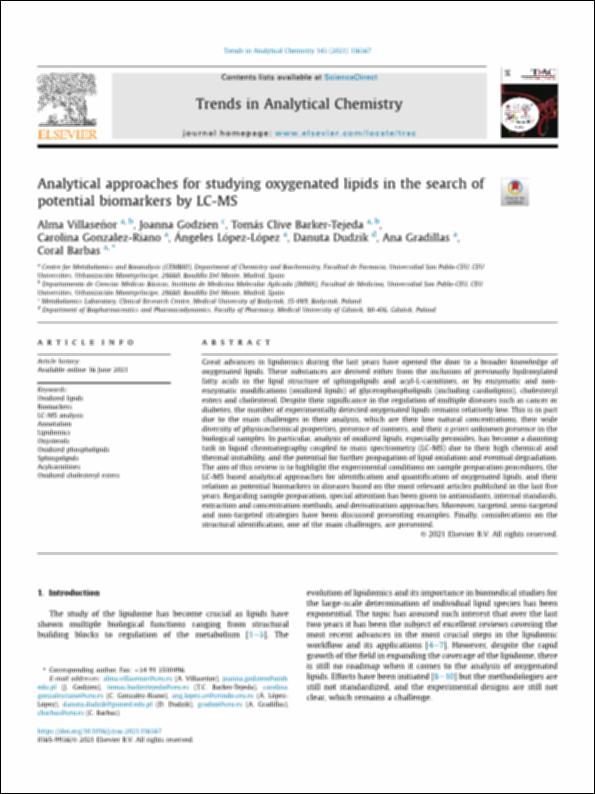Por favor, use este identificador para citar o enlazar este ítem:
http://hdl.handle.net/10637/13005Analytical approaches for studying oxygenated lipids in the search of potential biomarkers by LC-MS.
| Título : | Analytical approaches for studying oxygenated lipids in the search of potential biomarkers by LC-MS. |
| Autor : | Villaseñor Solis, Alma Cristina Barbas Arribas, Coral. González Riaño, Carolina Barker Tejeda, Tomas Clive Godzien, Joanna Barbara López López, Ángeles Dudzik, Danuta Gradillas Nicolás, Ana |
| Materias: | Oxidized lipids; Biomarkers LC-MS analysis; Annotation; Lipidomics; Oxysterols; Oxidized phospholipids; Sphingolipids; Acylcarnitines; Oxidized cholesteryl esters |
| Resumen : | Great advances in lipidomics during the last years have opened the door to a broader knowledge of oxygenated lipids. These substances are derived either from the inclusion of previously hydroxylated fatty acids in the lipid structure of sphingolipids and acyl-L-carnitines, or by enzymatic and nonenzymatic modifications (oxidized lipids) of glycerophospholipids (including cardiolipins), cholesteryl esters and cholesterol. Despite their significance in the regulation of multiple diseases such as cancer or diabetes, the number of experimentally detected oxygenated lipids remains relatively low. This is in part due to the main challenges in their analysis, which are their low natural concentrations, their wide diversity of physicochemical properties, presence of isomers, and their a priori unknown presence in the biological samples. In particular, analysis of oxidized lipids, especially peroxides, has become a daunting task in liquid chromatography coupled to mass spectrometry (LC-MS) due to their high chemical and thermal instability, and the potential for further propagation of lipid oxidation and eventual degradation. The aim of this review is to highlight the experimental conditions on sample preparation procedures, the LC-MS based analytical approaches for identification and quantification of oxygenated lipids, and their relation as potential biomarkers in diseases based on the most relevant articles published in the last five years. Regarding sample preparation, special attention has been given to antioxidants, internal standards, extraction and concentration methods, and derivatization approaches. Moreover, targeted, semi-targeted and non-targeted strategies have been discussed presenting examples. Finally, considerations on the structural identification, one of the main challenges, are presented. |
| Descripción : | En: TrAC Trends in Analytical Chemistry. ISSN 0165-9936 2021, v. 143, 116367 |
| URI : | http://hdl.handle.net/10637/13005 |
| Derechos: | http://creativecommons.org/licenses/by-nc-nd/4.0/deed.es |
| Fecha de publicación : | 16-sep-2021 |
| Centro : | Universidad San Pablo-CEU |
| Aparece en las colecciones: | Facultad de Farmacia |
Los ítems de DSpace están protegidos por copyright, con todos los derechos reservados, a menos que se indique lo contrario.


